The Marble Mountains boast many fascinating attractions such as: Âm Phủ Cave, Huyền Không Cave, Linh Ứng Pagoda, and Vọng Giang Dai…
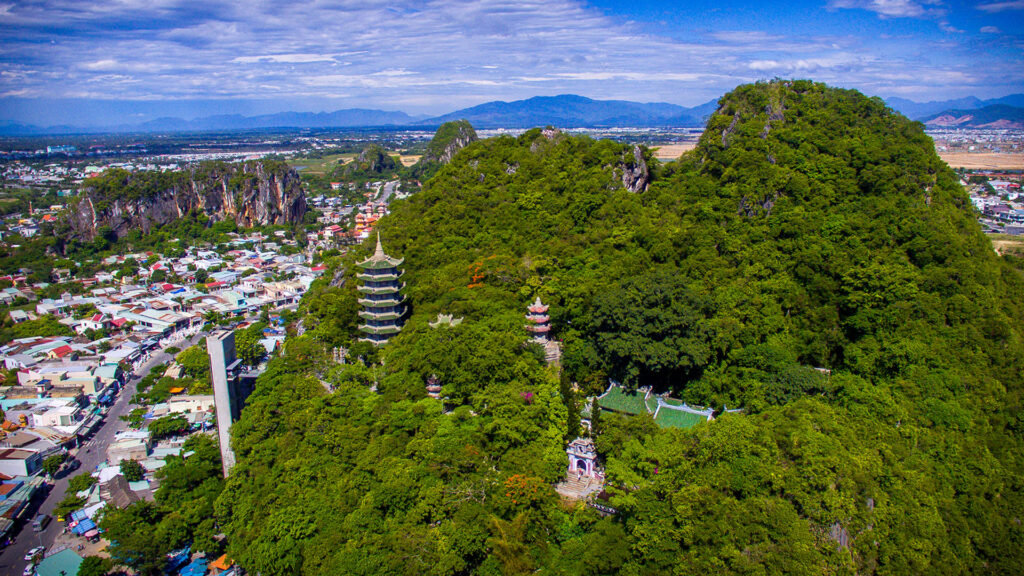
Address: 81 Huyen Tran Cong Chua Street, Ngu Hanh Son Ward, Da Nang City
Ticket Prices:
- Thuy Son Peak Visit: Adults: 40,000 VND/person/entry; Children under 6 years old: Free; Elevator service ticket: 15,000 VND/person/one-way (30,000 VND/round trip)
- Guided Tour Fee: 50,000 VND/group
- Âm Phủ Cave Visit: Adults: 20,000 VND/person/entry; Students: 7,000 VND/person/entry; Children under 6 years old: Free
* Visitors to Thuy Son Mountain can purchase tickets at either Gate 01 or Gate 02. Additionally, an elevator system is available to take visitors up the mountain. Those who choose to use the elevator must purchase an elevator transportation ticket.
GENERAL INTRODUCTION TO THE MARBLE MOUNTAINS
The Marble Mountains Scenic Area (commonly referred to as the Marble Mountains) is located in the southeast of Da Nang City, approximately 8 km from the city center. It borders the East Sea to the east; the Co Co River to the west; and residential areas of Hoa Hai Ward to the north and south.
The Marble Mountains enjoy an exceptionally favorable geographical position: a destination along the Central Vietnam heritage trail that links the ancient capital of Hue – Marble Mountains – the ancient town of Hoi An – and the My Son Sanctuary. The site offers mountains, rivers, and beaches, making it highly suitable for tourism development.
HIGHLIGHTED FEATURES
SPATIAL ARCHITECTURE OF TEMPLES AND CAVES
The Marble Mountains comprise a complex of six peaks: Thuy Son, Kim Son, Hoa Son (including Duong Hoa Son and Am Hoa Son), Tho Son, and Moc Son.
THUY SON PEAK, located in the northeast, is considered the most beautiful mountain and is commonly referred to by visitors as “Chua Non Nuoc” (Non Nuoc Pagoda). With charming landscapes, Thuy Son stretches from east to west across an area of 15 hectares. It is home to many ancient pagodas, stalactite-filled caves, and two prominent temples: Tam Thai Pagoda and Linh Ung Pagoda. The path leading up the mountain is composed of stone steps. At the summit, the three mountain peaks are named “Tam Thai” due to their resemblance to the “Tam Thai Stars”—three stars forming the tail of the Big Dipper constellation. Thuy Son features nine caves, five temples and towers, along with the Vong Giang Dai and Vong Hai Dai (Visitors can climb to Vọng Giang Dai to contemplate the landscapes of rivers and homeland, or to Vong Hai Dai, which opens up to sweeping views of the ocean and distant islands).
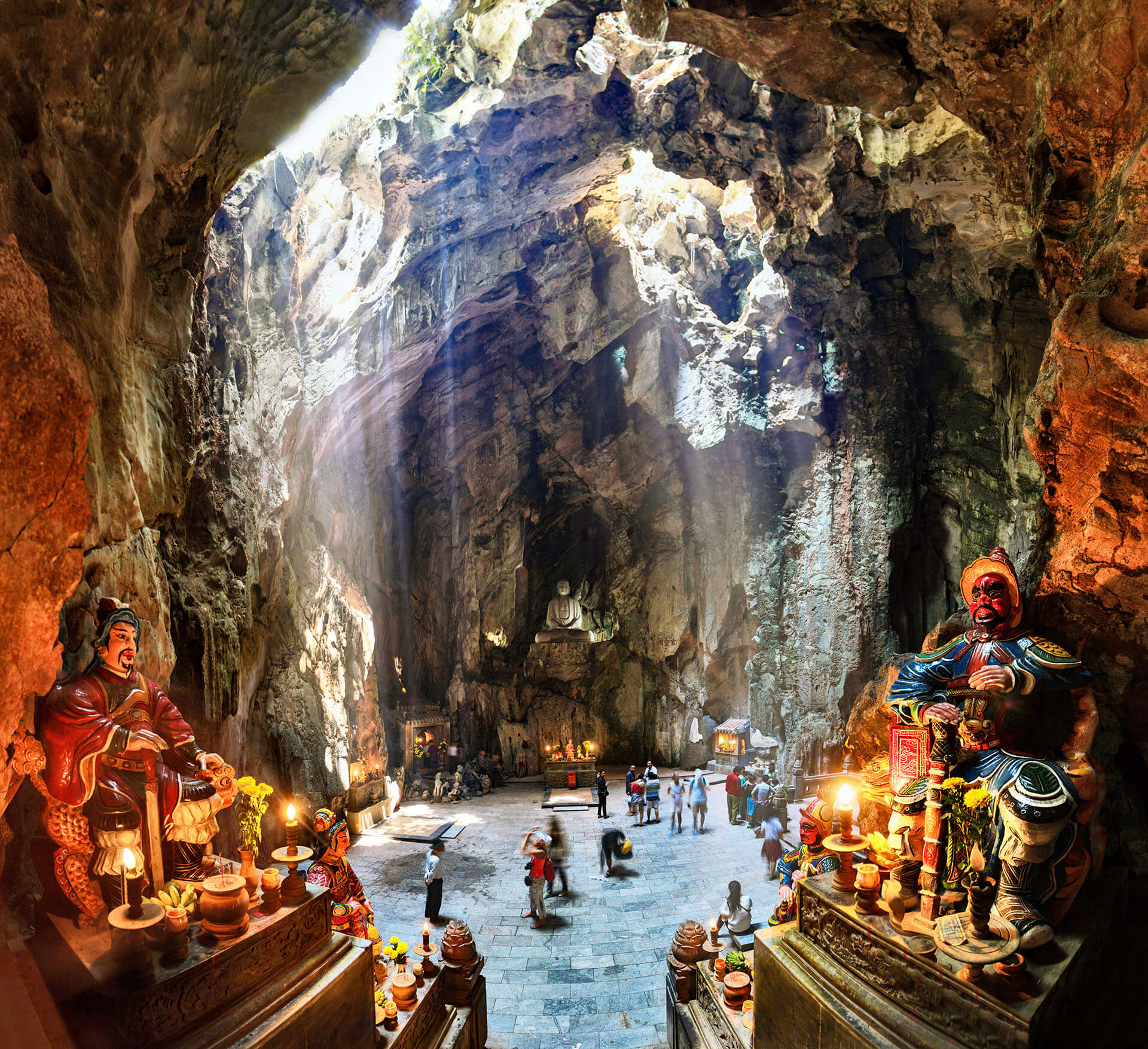
HUYEN KHONG CAVE contains on its altar a statue of Thien-Y-A-Na, the Jade Goddess. In ancient times, it was customary to conduct two sacred rituals, performed in solemn faith: “chicken blood oath” ceremonies were held to resolve disputes, ensuring truthfulness under the witness of spiritual beings. Participants would slaughter a rooster, pluck its feathers, and use a bowl of blood to swear an oath—believing that breaking the vow would bring death like the chicken itself. Many visitors came to the temple to pray for divine blessing, particularly women seeking fertility. They would then drink water from the stalactites inside Huyen Khong Cave. (Such rituals no longer exist today.)
AM PHU CAVE, situated south of Thuy Son, is a dark cavern lacking natural sunlight. The deeper one ventures, the darker it becomes—hence the name “Underworld Cave.” It is said that if marked grapefruits are placed inside the cave, they may resurface days later in the sea, suggesting the cave might connect to the ocean.
To the right of the temple, one may ascend via stone steps to Vong Hai Dai, from which the expansive scenery unfolds: golden sands and the vast sea stretch into the distance. Looking southeast, visitors can see Cu Lao Cham Island, with flocks of sea swallows soaring in the clear blue sky. Pham Hau, a celebrated poet from Quang Nam, once wrote a famous poem titled “Vong Hai Dai” during Vietnam’s New Poetry Movement (1932–1945). Emperor Minh Mang is regarded as the “chief architect” of the Marble Mountains—he was the one who commissioned the construction of the Vong Hai Dai.
In addition, there are the following caves: Linh Nham Cave, Hoa Nghiem Cave, Van Thong Cave (a cave that opens to the sky), Tang Chon Cave (located behind Linh Ung Pagoda, resembling a small valley measuring 10 meters long and 7 meters wide, airy thanks to an opening to the sky via Thien Long Coc), Thien Long Cave (Cave of Dragons and Heaven), Thien Phuoc Dia Cave, and Ngu Coc Cave.

Tam Thai Pagoda: Built in 1630, Tam Thai Pagoda was commissioned by Emperor Minh Mang in April 1826 to receive nine statues and three large bells. It still preserves the “Fiery Heart” and a bell engraved with the emperor’s name. The pagoda was restored in 1946 and again in 1975. In the spacious courtyard stands a large Maitreya Buddha statue, surrounded by bonsai trees and fragrant white and yellow plumeria flowers. At the back is the abbot’s residence, though today it serves only as a symbolic structure without a current abbot residing.
With over 200 years of history, the pagoda was originally constructed using baked bricks, molasses, and lime, but was later reinforced in 1907 with durable roof tiles after a major storm caused damage. The pagoda is built atop three mountain levels: Ha Thai, Trung Thai, and Thuong Thai—arranged to resemble three stars of the Big Dipper constellation, commonly referred to as “The Plow” by locals.
Linh Ung Pagoda: Facing the sea, Linh Ung Pagoda was originally built during Emperor Minh Mang’s reign in 1825 under the name “Ung Chan Tu.” In 1891, under Emperor Thanh Thai, it was renamed “Linh Ung Tu.” The temple houses a large statue of Avalokitesvara Bodhisattva and worships the Three Times Buddhas: Shakyamuni in the center, Maitreya on the right, and Amitabha on the left. In 1970, monks and Buddhists of Quang Nam – Da Nang rebuilt the temple.
The pagoda also honors the memorial tablet of Elder Buu Dai. Situated on Thuy Son Peak, Linh Ung is an ancient pagoda that faces east toward the sea, with its back nestled against the mountain—symbolizing strength and permanence. It was originally constructed in the first half of the 17th century during the reign of Emperor Canh Hung of the Later Le Dynasty, when a spiritual master named Quan Chanh came to live in seclusion and built a small hermitage called “Duong Chon Am” which later became a thatched hall named “Duong Chan Duong.”
When Emperor Gia Long visited the Marble Mountains, he ordered the rebuilding of the temple and granted it national status as “Royal Temple – Ung Chan Tu,” with Grand Master Bao Dai serving as abbot. In 1825, Emperor Minh Mang rebuilt the pagoda with brick and tile and renamed it “Ung Chon Tu,” which was then changed to “Linh Ung Pagoda” during Emperor Thanh Thai’s reign in 1891—a name it retains to this day. Other temples in the vicinity include Tam Ton Pagoda, Tu Tam Pagoda, and the Xa Loi Stupa.
KIM SON PEAK: Kim Son is the most modest of the six mountains, stretching east to west. The Truong River, once connected to the Da Nang River, used to welcome royal boats at Ben Ngu Pier. Over time, the landscape transformed into rice fields, and the Truong River—once called Lo Canh Giang and now known as the Co Co River—was partially buried, though remnants of the river still exist. On this mountain are two temples and two caves: Quan The Am Pagoda and Quan Am Cave, Thai Son Pagoda and Tam Thanh Cave.
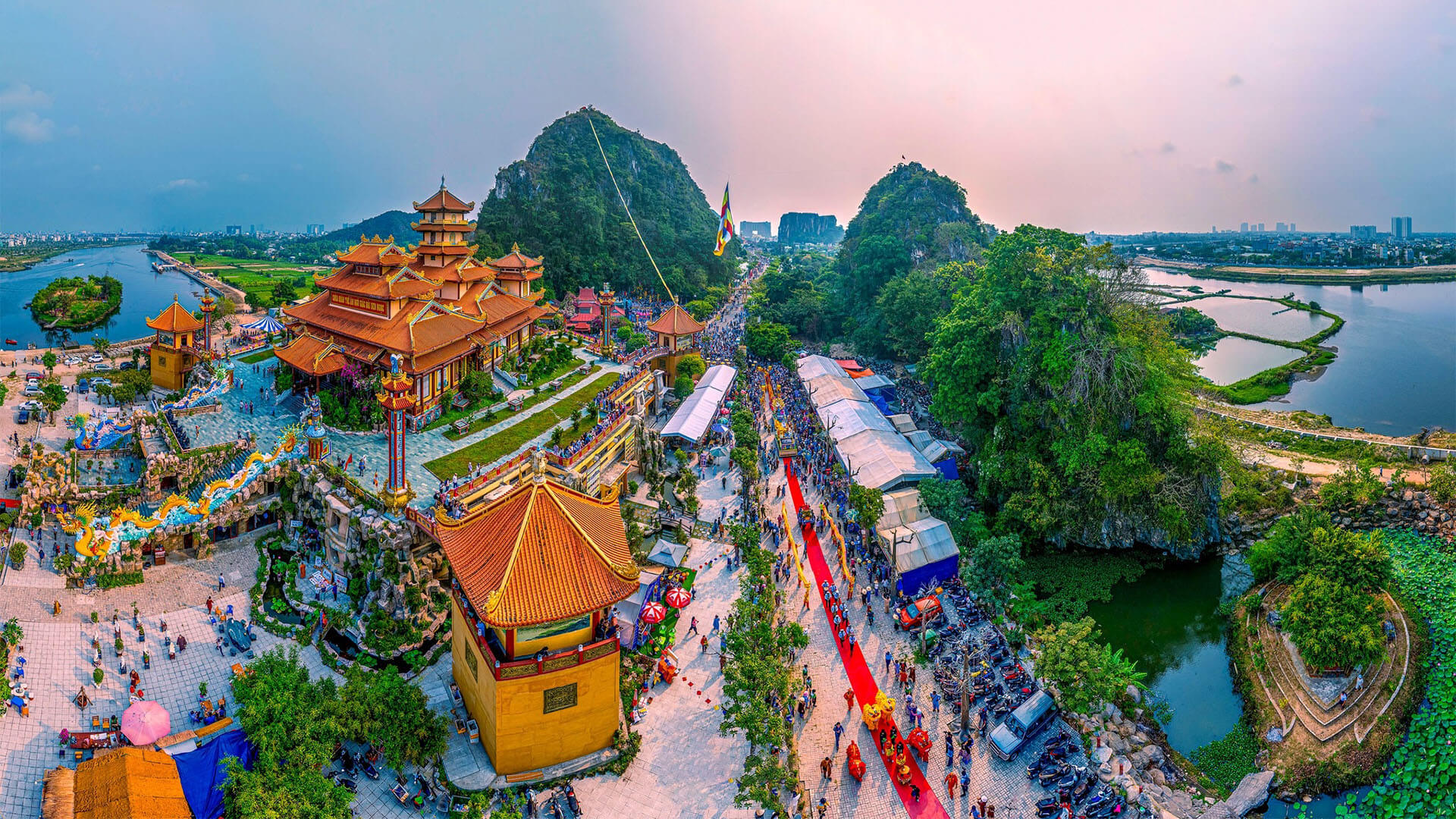
Quan The Am Pagoda is currently being expanded and houses a large stone temple that includes the Buddhist Cultural Museum—the first Buddhist museum in Vietnam—situated within a 700-square-meter courtyard. The museum displays more than 200 artifacts reflecting unique cultural values, such as statues of Avalokitesvara Bodhisattva with a child, Avalokitesvara riding a dragon-fish, and many sacred ancient statues including Shakyamuni, Medicine Buddha, Maitreya, Esoteric Bodhisattvas, Avalokitesvara of Cham culture, and Amitabha, along with bronze bells and the Eight-Sect Staff set.
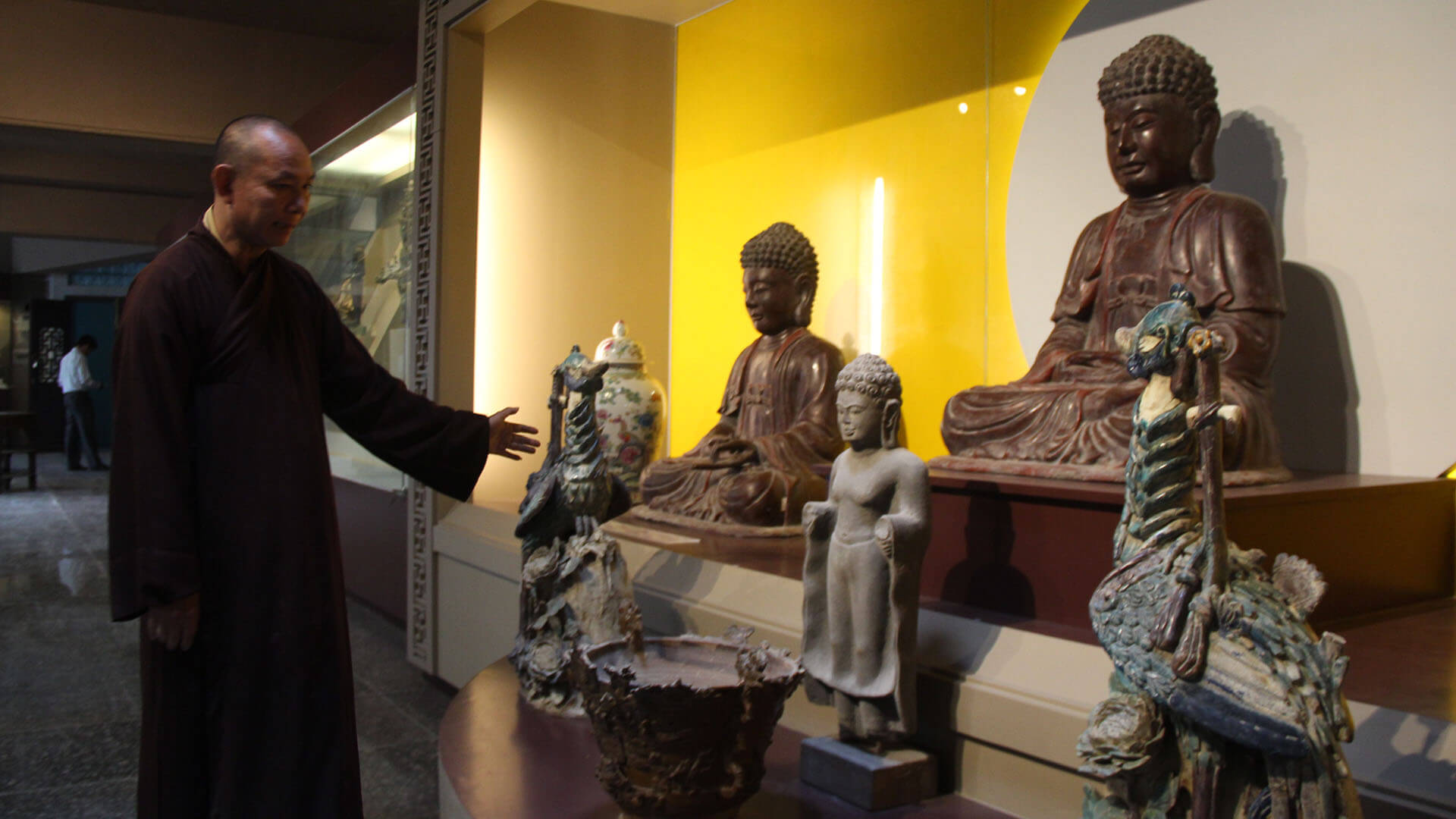
Additionally, the pagoda preserves many historical relics such as ancient wooden sutra plates, bronze censers, and worship items dating from the 7th to the 20th century.
THO SON PEAK: Tho Son is a low, square-shaped mountain located in the center, with uneven sides. It lacks natural scenic beauty and consists primarily of red clay and mixed sandstone. According to legend, Tho Son was a sacred area where the ancient Champa people once stationed troops. Traces of Champa civilization can still be found carved into the rocks—suggesting it served as a base for launching raids on trading vessels traveling from China to the Malay seas. Tho Son is encircled by taller peaks. It features four temples and one tunnel: Long Hoa Pagoda, Hue Quang Pagoda, Huong Son Pagoda, Giac Hoang Vien, and the Stacked Stone Tunnel.
MOC SON PEAK: Moc Son lies to the southeast, running parallel to Thuy Son Peak. Despite its name meaning “Wood Mountain,” it is sparsely vegetated, with steep cliffs. The mountain contains no temples, only a white marble block locally referred to as “Co Mu” or “Avalokitesvara.” Beneath the mountain is a small cave known as Ba Trung Cave.
(Note: Long Hoa Pagoda, Hue Quang Pagoda, Huong Son Pagoda, Giac Hoang Vien, and the Stacked Stone Tunnel also appear in relation to Moc Son.)
CERTAIN CULTURAL ELEMENTS, FESTIVALS, AND TRADITIONAL CRAFT VILLAGES ASSOCIATED WITH THE MARBLE MOUNTAINS
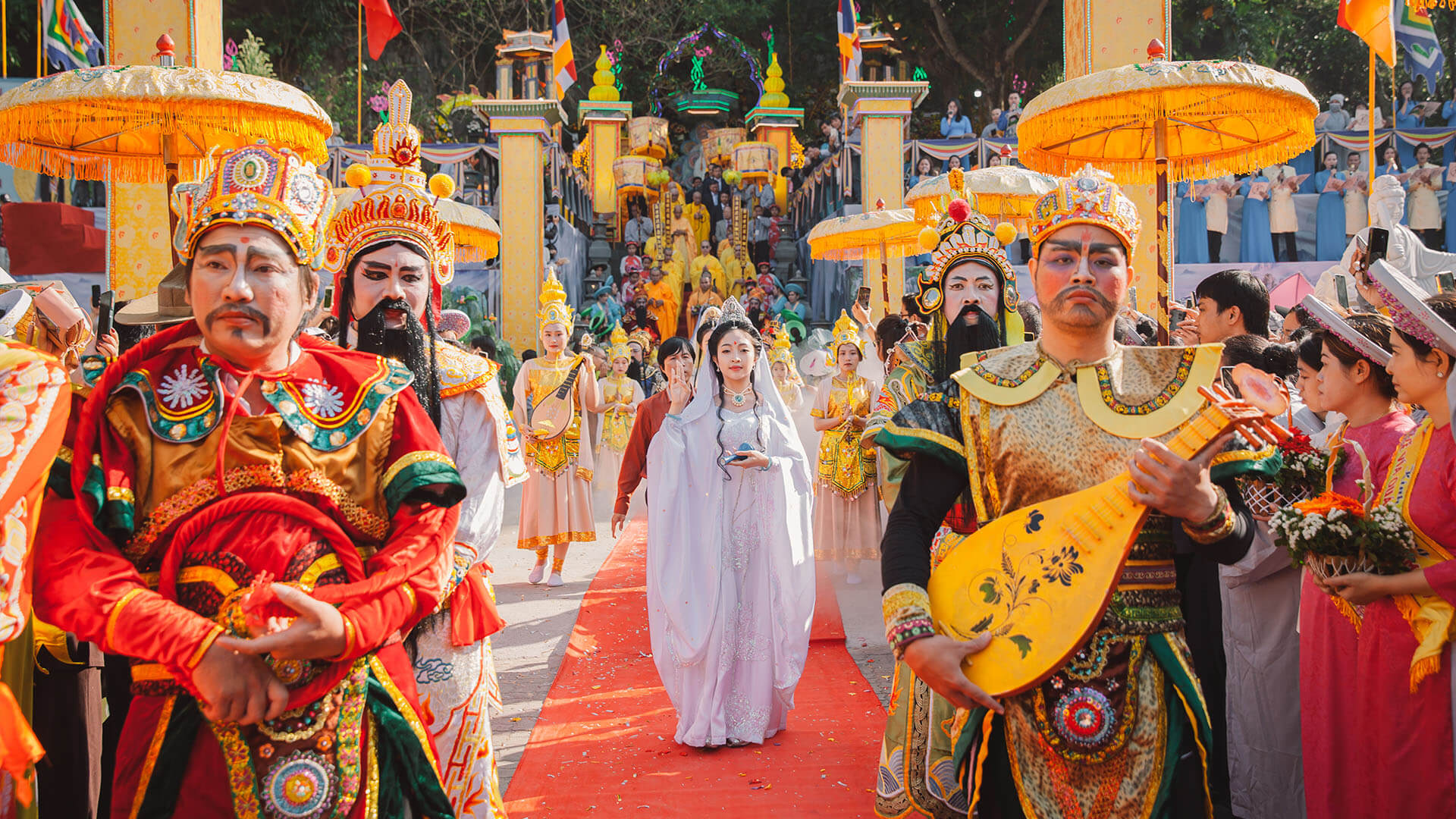
AVALOKITESVARA BODHISATTVA FESTIVAL
In 1956, Venerable Thich Phap Nhan discovered a naturally formed stalactite statue of Avalokitesvara Bodhisattva (Quan The Am), holding a vase of sweet dew, inside a cave on Kim Son mountain. The statue, life-sized and perfectly intact, was surrounded by a sacred world depicting the Bodhisattva: including Jade Maidens, Kind Sages, Sea Lions, bamboo groves, and more.
Based on this spiritual revelation, in 1962, on the occasion of inaugurating a newly constructed temple, Venerable Thich Phap Nhan organized a commemoration on the 19th day of the second lunar month—marking the first celebration of the Avalokitesvara Bodhisattva Festival. This day has since become an important annual event.
By 1991, as festivals across the country were being actively revived and in response to UNESCO’s “Decade of Cultural Return to Roots” campaign, the People’s Committee of Quang Nam – Da Nang (former province) and the Provincial Buddhist Association approved a plan by Venerable Thich Hue Huong of Quan The Am Pagoda to formally establish this festival as an annual traditional celebration. The “Avalokitesvara Bodhisattva Festival – Marble Mountains – Non Nuoc” was thus officially held from the 17th to the 19th day of the second lunar month each year.
Since then, the festival has been held regularly every spring. By the end of 1999, the Avalokitesvara Bodhisattva Festival was officially recognized by the State as one of Vietnam’s fifteen national-level folk festivals.
This is a cultural festival that embodies folk traditions and Buddhist spiritual identity. The festival consists of two parts: the ceremonial and the festive. The ceremonial part follows solemn Buddhist rituals. The festive part spans three days and nights, filled with vibrant and enthusiastic cultural, sports, entertainment, and recreational activities.
With its scale and unique form, the “Avalokitesvara Bodhisattva Festival – Non Nuoc – Marble Mountains” Festival has become a distinct spiritual event that blends Buddhist legend with national cultural traditions, attracting a large number of devotees, local residents, and domestic and international tourists.
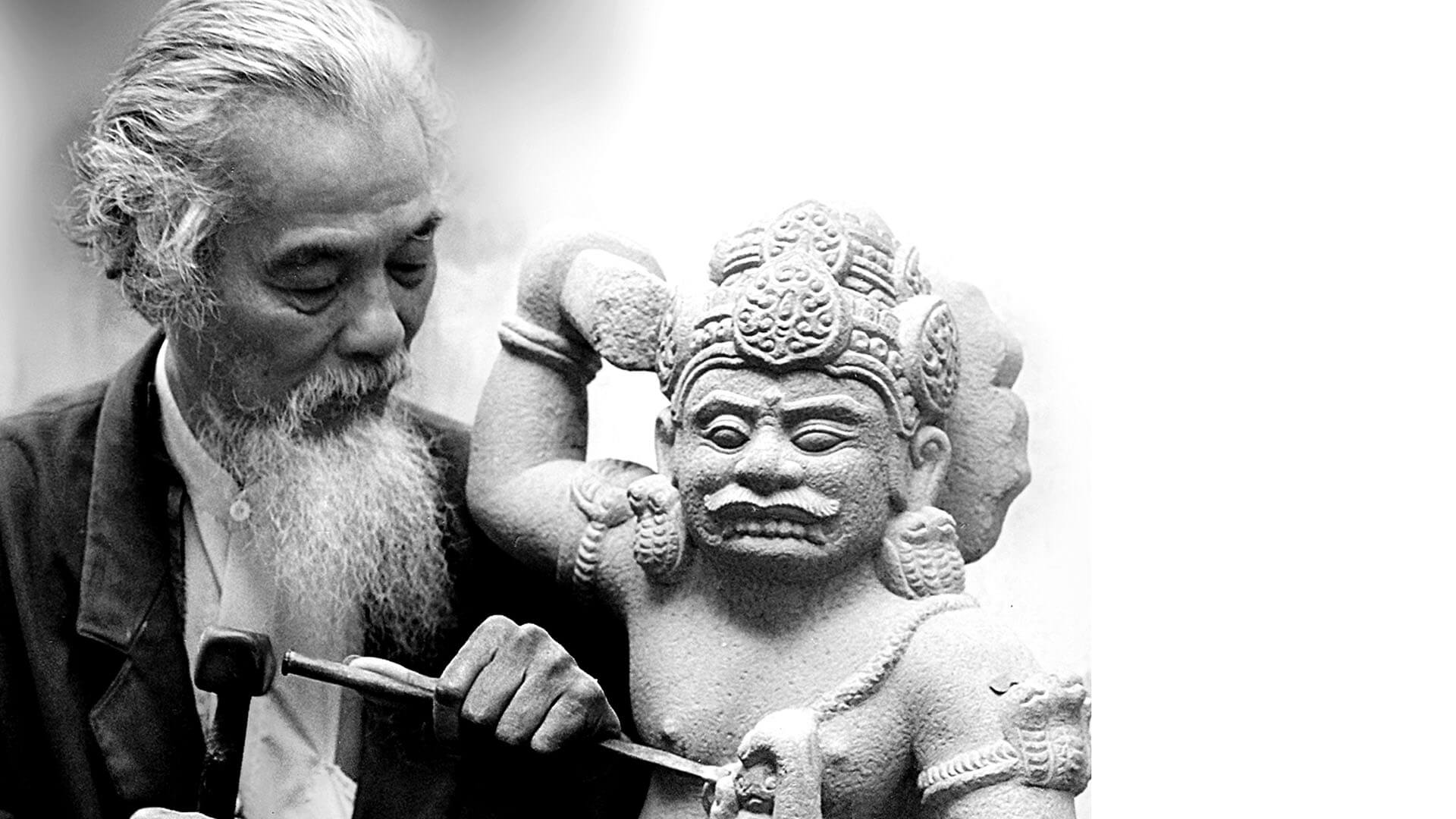
NON NUOC STONE CARVING VILLAGE
Stretching along the foot of the Marble Mountains is the Non Nuoc Stone Carving Village. Though the exact founding year is unknown, a stele at Pho Khanh Pagoda (located in Ai Nghia Village—one of the oldest pagodas in Quang Nam, now part of Dai Hoa Commune, Dai Loc District, Quang Nam Province), engraved in the year Mau Ngo, Vinh Tri 3rd year (1678) under the reign of King Le Hy Tong, clearly notes that the origin of the stele carver was from “Quán Khái Village” (now located in Hoa Quy Ward, Ngu Hanh Son District).
Based on this inscription, it is evident that Quan Khai Village had long engaged in the craft of carving steles and chiseling inscriptions, dating back at least to the 17th century. The stele also records that the original sculptors came from Thanh Hoa province and settled in Quan Khai Village—at a time when there were no other villages or inhabitants at the foot of the Marble Mountains. The founding ancestor of Non Nuoc Stone Carving Village is Master Huynh Ba Quat, who is credited with bringing the stone carving craft from Thanh Hoa to the Marble Mountains region.
Later, due to the village’s growth and the increasing popularity of stone artworks as valuable gifts for tourists, many artisans relocated to the foot of the Marble Mountains in Hoa Hai Ward. Today, in Dong Hai quarter of Hoa Hai Ward, there is a temple named “Thach Nghe To Su” (Temple of the Stone Art Ancestor), and the 6th day of the first lunar month is celebrated annually as the ancestral death anniversary.
Local workshops and hundreds of stone carvers solemnly present offerings and burn incense in reverence and gratitude to the forefathers who established and developed the village to this day. In 2014, Non Nuoc Stone Carving Village was recognized as a National Intangible Cultural Heritage.
Today, many unique and exquisite stone artworks from Non Nuoc Stone Carving Village have been exported to numerous international markets around the world.
SUGGESTED ITINERARY
With its favorable location along the Da Nang – Hoi An route, the Marble Mountains are often combined with a visit to Hoi An Ancient Town within the same day. Below is a suggested itinerary to help visitors fully explore the Marble Mountains.
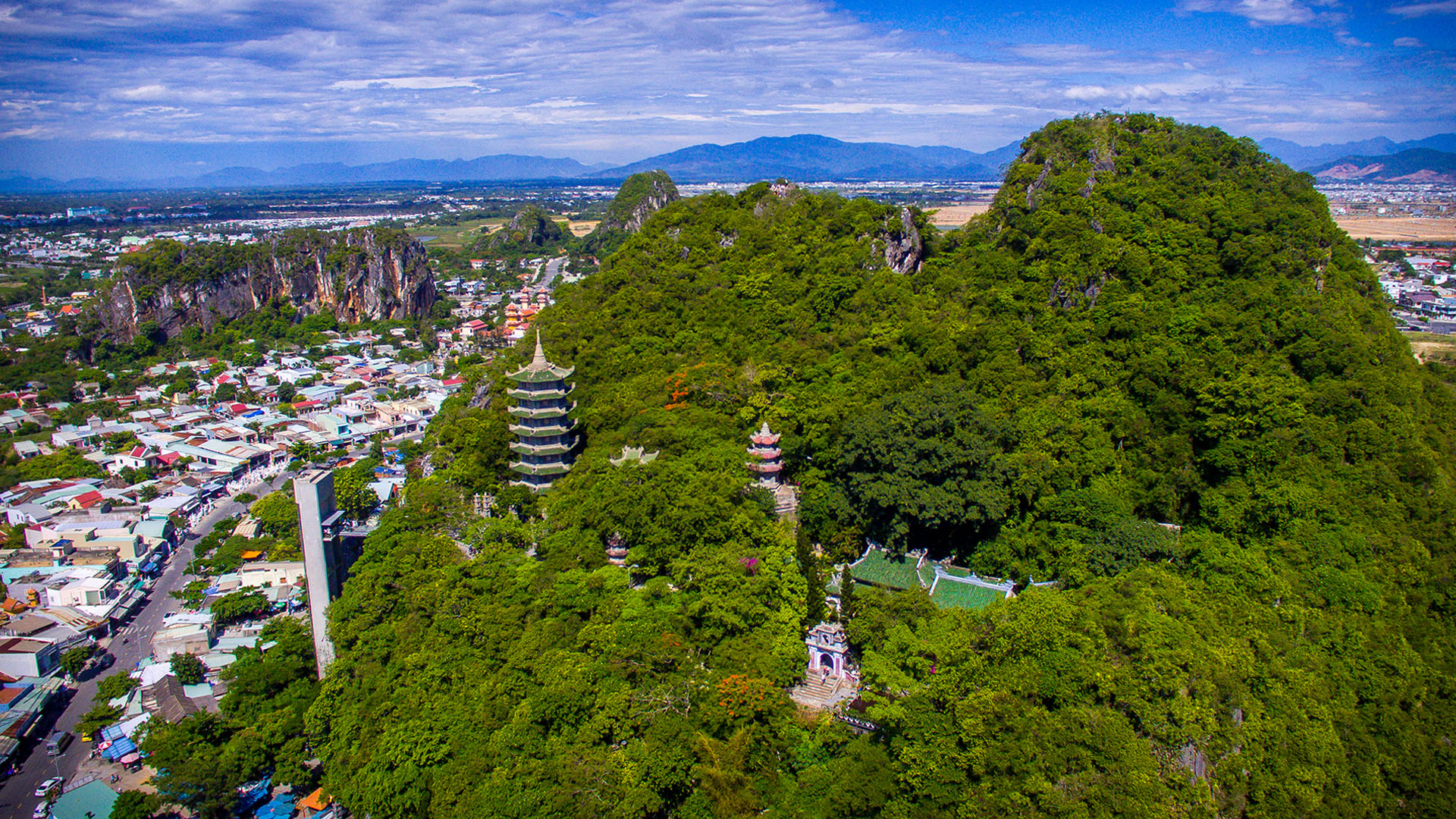
A panoramic view of the Marble Mountains from above showcases the harmonious beauty of mountains, caves, and ancient temples.
- Ideal timing: It is recommended to depart from Da Nang city center around 7:30 – 8:00 AM. Early morning offers the most pleasant weather for hiking and cave exploration. Especially during summer, visitors should arrive before 9:00 AM or after 4:00 PM to avoid the intense midday heat. From Da Nang, it takes approximately 15 minutes to reach the Marble Mountains, with the visit starting around 8:30 AM.
- Suggested duration: Allocate about 3–4 hours in the morning to discover the prominent features of the Marble Mountains. Visitors should prioritize Thuy Son, the largest and most beautiful of the five mountains. Notable highlights here include Linh Ung Pagoda, Tam Thai Pagoda (over 400 years old), and several mystical caves such as Huyen Khong Cave, Tang Chon Cave, and the well-known Am Phu Cave. There are two ways to ascend Thuy Son: by climbing more than 150 stone steps or taking the glass elevator (15,000 VND/way), depending on one’s physical condition. At the summit, be sure to visit Vong Giang Dai to take in the sweeping view of the surrounding landscape and cityscape from above. The morning air is fresh, and the distant sound of temple bells creates a serene atmosphere well worth experiencing.
- After leaving the Marble Mountains, visitors may continue their journey to Hoi An. From the Non Nuoc area, it takes about 30 minutes by car along the scenic Truong Sa – Lac Long Quan coastal road to reach Hoi An.
Today, the Marble Mountains are not only a magnificent natural wonder but also an important complex of historical and cultural relics—where unique tangible and intangible heritage values converge. The prestigious titles awarded between 2019 and 2023 have affirmed the significance and stature of the Marble Mountains, while also serving as a driving force for the local community to continue preserving and promoting these heritage values for future generations.
DANANG CENTER FOR TOURISM PROMOTION